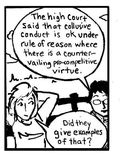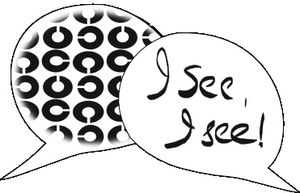By Dr. Ken Broda Bahm:
P: Hey, have you seen the amicus brief that was written entirely as a cartoon?
S: A cartoon? You mean someone submitted a joke as an amicus brief?
 P: No, not a joke. The lawyer, Bob Kohn, lays out his argument in a series of frames with characters and dialogue, like this. You can see the whole thing here.
P: No, not a joke. The lawyer, Bob Kohn, lays out his argument in a series of frames with characters and dialogue, like this. You can see the whole thing here.
S: Wow, did it work?
P: Not in the specific case. The judge went the other way just one day after receiving this cartoon. But it may get better mileage in the court of public opinion, through media coverage and in blog posts including this one.
S: Speaking of blog posts, why are we in dialogue mode rather than straightforward exposition?
P: Glad you asked — that is the interesting part of it. If you look at Kohn’s complete brief, it works not so much because of the imagery, but because it is a conversation – a dialogue. The vast majority of the frames in the cartoon – 37 out of 45 – are just two people talking.
S: That is interesting. Why does dialogue work?
P: Because our brains respond to it. The simple back-and-forth is punchy, clear in purpose, and easy to understand.
S: That’s true. In just 800 words I was able to understand a pretty complex argument on antitrust issues in the e-book market.
P: Right, the technique actually has more in common with the Socratic dialogues than with modern graphics or conventional cartoons.
S: Okay, that is cool, but is there a larger point for legal persuasion?
P: Absolutely, there is a point for all litigators in and out of court. No, I’m not saying lawyers can switch to cartoons or engage in imaginary ‘Eastwooding‘ conversations in court. But lawyers can apply many of the principles of dialogue to make their persuasion simpler and more effective, and that’s what the rest of this conversation will be about.
S: I figured.
P: The most important lesson of the amicus cartoon is that dialogue can aid explanation and persuasion. And there are several contexts in which litigators can increase their effectiveness by incorporating the principles of dialogue. That’s actually an idea that ties together a lot of the advice given in this blog.
S: That dialogue is more persuasive than monologue?
P: Exactly.
Oral Arguments
P: Let’s start with the most direct interchange you’ll have with your judge: oral argument.
S: Yes, it can be tough to stick to your prepared remarks when your judge is constantly interrupting with questions and counterarguments.
P: No, a hot bench isn’t a problem, it is an opportunity. Take the example of Paul Clement’s argument to the Supreme Court on healthcare. Nearly all arguments at that level are executed as a dialogue with the judges and not as a monologue.
S: And the same principle applies to arguments with your local magistrate judge?
P: Yes, as long as the judge tells you, or you can estimate what the judge is thinking.
Jury Selection
S: Does that same principle apply to a jury?
P: Certainly, and especially during the one moment you can actually have a conversation with them.
S: Attorney conducted voir dire.
P: Right. It should be a conversation, but too many attorneys use that opportunity to just ask long questions that end with the potential juror saying “yes.” Like, “Wouldn’t you agree that consumers have a responsibility to use a product safely?”
S: They’re laying out their themes and ‘priming’ the jurors.
P: Yes, but it is usually pretty transparent, it doesn’t truly ‘commit’ jurors to anything, and it is better to use that time to actually learn something about your panelists that would inform a strike or cause challenge.
S: And, let me guess, you do that through dialogue – actually talking with them and listening.
P: Bingo.
Opening Statement
S: If only that conversation could extend into opening statement.
P: Well, in a way, it can. No, you can’t talk with them, and no, you can’t just rely on their non-verbal responses, but you can base your opening on the questions you expect jurors to have.
S: The opening should just tell the story in a way that favorably frames your client’s case, right?
P: Right, but you can move the story along using rhetorical questions reflecting jurors’ genuine needs for information.
S: Like beginning a section by asking, “What actions did the company take to minimize the risks of accident?”
P: Right, these rhetorical questions reflect what jurors might be asking themselves already, and help to frame a key part of the story.
Closing Argument
S: So, I’ll bet closing is potentially a dialogue too, but in a different way.
P: That’s right. In closing arguments, the story you’re telling isn’t a story about what happened, but is a story about the upcoming deliberations.
S: The questions the jurors will be asking themselves in order to reach a verdict?
P: Yes, and that includes the questions on the verdict form, as well as all the questions they’ll be asking themselves in order to get to these answers.
S: And closing argument can help jurors prepare for that dialogue?
P: It can and it should. Instead of using your one opportunity to argue as a time to just hurl arguments at the jury, it is more effective to position yourself as a guide. Jurors feel they’re reaching their own conclusions instead of yours if you are leading jurors through the right questions and the right information that helps them answer the questions in the right way.
Witness Examination
S: An earlier example of the need to get the right questions answered in the right ways is direct examination.
P: Right, that truly is a dialogue, and rather than just walking a fact or expert witness through the elements of her testimony…
S: …like checking items off a checklist…
P: …It is better for the examining attorney to act as the “voice of the jury” by asking what they’d ask, and puzzling over the same things they would puzzle over. That way, the jury vicariously participates in the dialogue during direct.
S: Not much dialogue during cross though.
P: Not usually, but there can be. When witnesses restrict themselves to just “yes,” “no,” “I don’t know,” and “I don’t remember,” then it really is a monologue by opposing counsel. And that’s not good. If the witness is trained to fight back effectively in cross, you have a good shot at a dialogue that includes your side.
Briefing
S: So let’s go back to the example we began with — a brief. Surely a lawyer’s written product, at least when it isn’t in cartoon form, is an argument in a single voice.
P: No, not necessarily. The style of briefing that just says, “Here are my arguments,” is dry to write and boring to read. If, instead, the brief is a back-and-forth between “Here is what they’ve said or will say” and “Here is why they’re wrong,” then it is more engaging.
S: And more effective, because it tracks the judge’s own evaluation and decision making.
P: Right. And if blog readers had infinite patience, we could keep going. Graphics, instructions, mediations, and just about every other aspect of the legal persuasion process is better when it is conceived as dialogue.
S: I love it when a theme ties everything together!
P: Yep, If you want to persuade, think dialogue.
______
S: What are some other posts on interesting modes of persuasion?
P: Try some of these:
- Ethos, Pathos, and Logos: Use All Three in Your Legal Writing and Oral Argument
- Take Some Storytelling Lessons From Pixar
- Play It Where It Lies: Throughout Trial, Match theMessage to the Mindset
- Find the “Universal Morality” in Your Case Story
_____
Image Credit: nad2000, Flickr Creative Commons
